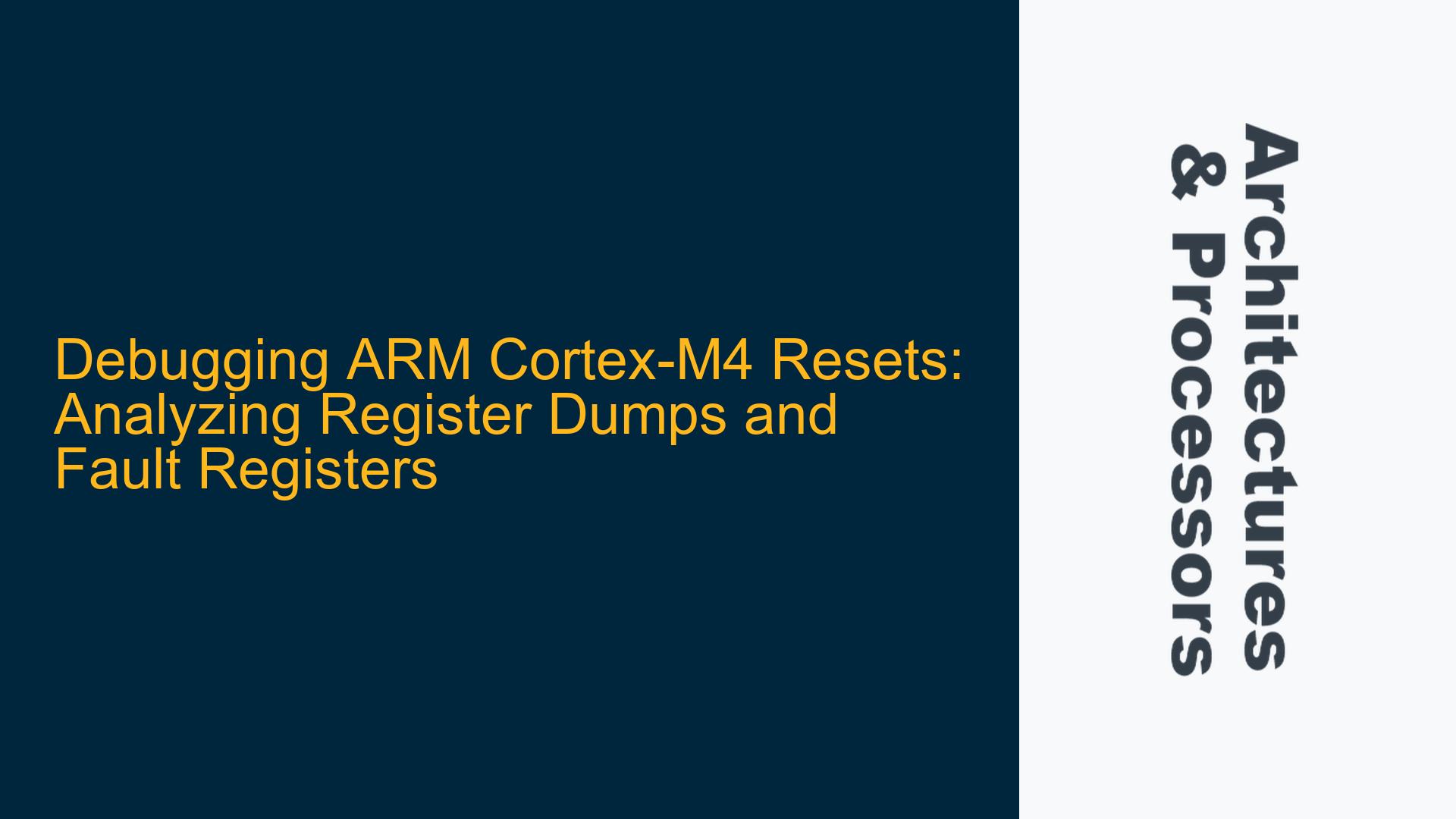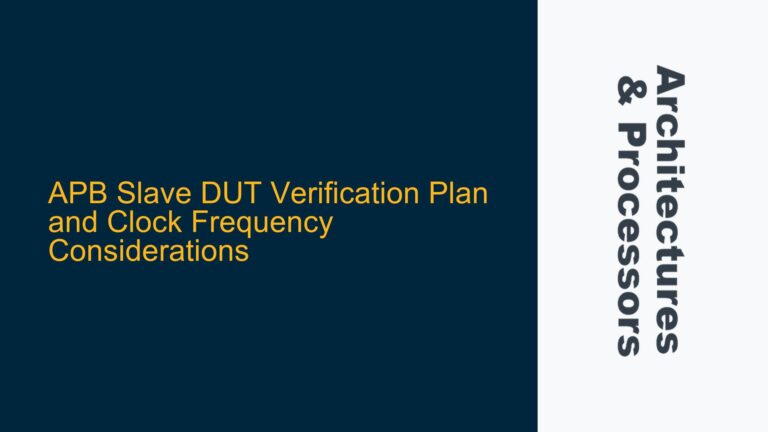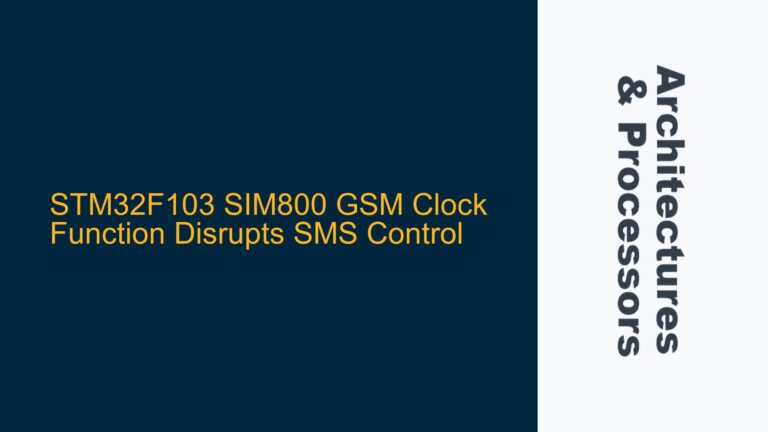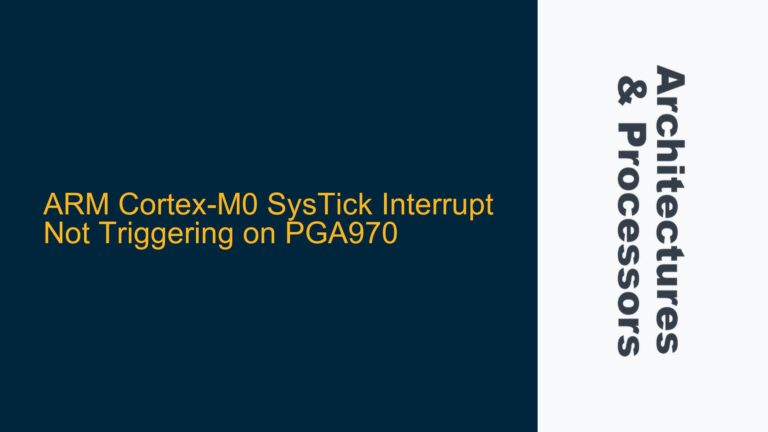ARM Cortex-M4 Unexpected Reset with PC = 0x00000000 and HFSR = 0x40000000
The issue at hand involves an unexpected reset occurring during the normal operation of a system based on the ARM Cortex-M4F processor, specifically the Tiva TM4C129XNCZAD microcontroller. The reset is accompanied by a register dump that reveals critical information about the state of the processor at the time of the fault. Key observations from the register dump include the Program Counter (PC) being set to 0x00000000, the HardFault Status Register (HFSR) showing a value of 0x40000000, and other fault status registers such as the Usage Fault Status Register (UFSR) and Debug Fault Status Register (DFSR) providing additional clues. These registers collectively indicate that a severe fault has occurred, leading to a system reset. Understanding the root cause of this fault requires a detailed analysis of the register values, the fault status registers, and the potential interactions between the software and hardware that could have triggered the fault.
The Program Counter (PC) being set to 0x00000000 is particularly significant. This value suggests that the processor attempted to execute code from address 0x00000000, which is typically an invalid or non-executable memory region in most embedded systems. This could occur due to a null function pointer dereference, a stack corruption, or an invalid branch instruction. The HardFault Status Register (HFSR) value of 0x40000000 indicates that a forced hard fault has occurred, which is often triggered by an escalation of a lower-priority fault such as a bus fault, memory management fault, or usage fault. The UFSR value of 0x0002 suggests that an undefined instruction or an invalid state transition might have been attempted, while the DFSR value of 0x00000001 indicates that a debug event, such as a breakpoint or watchpoint, might have contributed to the fault.
Null Pointer Dereference, Stack Corruption, and Fault Escalation
The primary suspect in this scenario is a null pointer dereference, which is a common cause of system crashes in embedded systems. A null pointer dereference occurs when the program attempts to access or execute code from a memory location pointed to by a null pointer (0x00000000). This can happen if a function pointer is inadvertently set to NULL and then called, as illustrated in the example provided in the discussion:
void (*fp)(void);
fp = NULL;
fp();
In this case, the program counter (PC) would jump to 0x00000000, leading to an immediate fault. The processor would then escalate this fault to a hard fault, resulting in a system reset. However, a null pointer dereference is not the only possible cause. Stack corruption is another potential culprit. If the stack is corrupted due to a buffer overflow, an incorrect stack pointer initialization, or an interrupt service routine (ISR) that overwrites critical stack data, the processor might attempt to execute code from an invalid address, including 0x00000000. Stack corruption can also lead to other types of faults, such as bus faults or memory management faults, which could escalate to a hard fault.
Another possible cause is an invalid state transition or an undefined instruction execution. The ARM Cortex-M4 processor has a well-defined set of instructions and state transitions. If the processor encounters an undefined instruction or attempts an invalid state transition, it will trigger a usage fault. If this fault is not handled properly, it can escalate to a hard fault, leading to a system reset. The UFSR value of 0x0002 indicates that an undefined instruction or invalid state transition might have occurred, which aligns with this possibility.
Fault escalation is a critical aspect of the ARM Cortex-M4 fault handling mechanism. When a lower-priority fault (such as a usage fault, bus fault, or memory management fault) occurs and is not handled by the corresponding fault handler, the processor escalates the fault to a hard fault. The HFSR value of 0x40000000 indicates that a forced hard fault has occurred, which means that a lower-priority fault was escalated. The DFSR value of 0x00000001 further suggests that a debug event might have been involved in the fault escalation process. Debug events, such as breakpoints or watchpoints, can sometimes interfere with normal program execution and lead to unexpected faults if not handled correctly.
Analyzing Register Dumps, Implementing Fault Handlers, and Debugging Strategies
To diagnose and resolve the issue, a systematic approach is required. The first step is to analyze the register dump in detail. The register values provide a snapshot of the processor state at the time of the fault, and careful examination can reveal valuable insights into the root cause. The Program Counter (PC) value of 0x00000000 is a clear indicator that the processor attempted to execute code from an invalid address. The Link Register (LR) value of 0x00073135 can be used to trace back to the function that was executing at the time of the fault. The Stack Pointer (SP) value of 0x20034e18 should be examined to determine if the stack was corrupted or if it points to an invalid memory region.
The fault status registers (HFSR, UFSR, DFSR, etc.) provide additional clues about the nature of the fault. The HFSR value of 0x40000000 indicates that a forced hard fault occurred, which means that a lower-priority fault was escalated. The UFSR value of 0x0002 suggests that an undefined instruction or invalid state transition might have been attempted. The DFSR value of 0x00000001 indicates that a debug event might have been involved in the fault escalation process. These registers should be carefully examined to understand the sequence of events that led to the fault.
Once the register dump and fault status registers have been analyzed, the next step is to implement or enhance fault handlers. The ARM Cortex-M4 processor provides a set of fault handlers that can be used to catch and handle different types of faults. These include the HardFault handler, the MemManage handler, the BusFault handler, and the UsageFault handler. By implementing these handlers, it is possible to catch faults before they escalate to a hard fault and cause a system reset. The fault handlers can be used to log fault information, such as the faulting address, the type of fault, and the processor state at the time of the fault. This information can be invaluable for debugging and resolving the issue.
In addition to implementing fault handlers, it is important to review the code for potential issues that could lead to null pointer dereferences, stack corruption, or invalid state transitions. This includes checking for uninitialized function pointers, ensuring that stack sizes are adequate, and verifying that interrupt service routines (ISRs) do not overwrite critical stack data. Static code analysis tools can be used to identify potential issues in the code, and runtime checks can be added to detect and handle invalid memory accesses or state transitions.
Debugging strategies should also include the use of breakpoints, watchpoints, and trace tools. Breakpoints can be set at critical points in the code to monitor program execution and identify where the fault occurs. Watchpoints can be used to monitor specific memory locations for changes, which can help detect stack corruption or invalid memory accesses. Trace tools, such as ARM’s Embedded Trace Macrocell (ETM), can be used to capture a detailed trace of program execution, which can be analyzed to understand the sequence of events leading up to the fault.
Finally, it is important to consider the impact of the operating system (OS) and the runtime environment on the fault. In this case, the system is running TI-RTOS, which may have its own set of fault handling mechanisms and debugging tools. The OS should be configured to provide detailed fault information, and any OS-specific debugging tools should be used to complement the ARM-specific debugging strategies.
In conclusion, the unexpected reset in the ARM Cortex-M4 system is likely caused by a null pointer dereference, stack corruption, or an invalid state transition, leading to a fault that escalates to a hard fault. By carefully analyzing the register dump, implementing fault handlers, reviewing the code for potential issues, and using debugging tools, it is possible to diagnose and resolve the issue. The key is to take a systematic approach, leveraging the detailed information provided by the processor’s fault status registers and the debugging capabilities of the ARM Cortex-M4 architecture.






